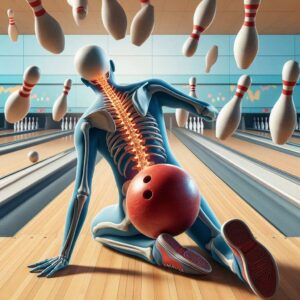Bowling lane arrows are an indispensable part of the bowling experience, especially for beginners looking to improve their accuracy and consistency. These small triangular markers embedded across the lane serve many important purposes that bowlers should understand and utilize properly.
In this comprehensive guide, we’ll explain what bowling lane arrows are, discuss their key functions, and provide tips for using them effectively as a new bowler.
Whether you are bowling your first game ever or simply looking to enhance your skills, learning how to properly line up shots using the lane arrows is an essential skill.
What Are Bowling Lane Arrows?
Bowling lane arrows, sometimes referred to as range finder arrows, are the 7 small triangular markers embedded across each lane that extend from the foul line toward the pins.
They are located about 15 feet apart starting about 12 feet from the foul line. The arrows help guide bowlers to the ideal starting positions and angles for delivering their shots.
Lane arrows provide fixed reference points that bowlers can utilize when aiming. By lining up relative to the arrows at the beginning of each frame, bowlers can establish consistency in their foot placement and approach angle. This in turn improves accuracy, power, and control from frame to frame.
Understanding the Functions of Lane Arrows
The primary functions of bowling lane arrows include:
- Helping bowlers consistently line up effective starting positions frame after frame
- Serving as visual targeting aids during the bowler’s approach
- Enabling bowlers to make incremental adjustments across the lane to improve accuracy
- Assisting bowlers in identifying oil patterns to adjust technique and line up shots
Consistent Lining Up of Starting Positions
One of the biggest challenges in bowling is replicating the exact same starting position and approach angle on every shot. Small inconsistencies in foot placement from frame to frame lead to major inconsistencies in shot accuracy. This frustration is exactly what lane arrows help bowlers overcome.
By using the arrows as guides, a bowler can line up in the same relationship to a specific arrow before each shot. For example, always place the sliding foot between the 3rd and 4th arrows. This improves consistency and feels immense for learning bowlers.
Visual Targeting Aids During Approach
In addition to assisting with pre-shot alignment, lane arrows also serve as visual targeting aids as bowlers go through their approach motions. Keeping the eyes focused on a target is critical in every sport. The arrows provide an optimal focal point down the lane rather than the overwhelming sea of pins at the end.
Aiming for an arrow or specific point between arrows gives bowlers a clear target to stride towards during the approach. This enhances accuracy, timing, and alignment. Visualizing the arrow throughout the swing and release is key.
Making Adjustments Across the Lane
As bowlers gain experience, they realize that different starting positions and approach angles are required depending on the oil patterns on the lane. The arrows provide reference points for bowlers to make incremental adjustments across the lane to find the ideal lineup for a given oil pattern.
For example, adjustments may include moving the feet left or right a certain number of arrows to change the angle. Bowlers also use the arrows to make alignments for picking up tough splits and hitting specific pins when aiming for spares.
Identifying Oil Patterns
The arrows are invaluable for revealing and deciphering oil patterns on the lane surface. As balls begin hooking down the lane, experienced bowlers can analyze their curves in relation to the arrows to identify the type of oil pattern being used. Once the pattern is determined, proper adjustments can be made.
Straight vs. Hook Shots
Another key purpose of the arrows is to assist bowlers with aligning both straight and hook shots. Straight shots with no hook require different starting positions and visual aiming points than hook shots. We’ll examine arrow techniques for both.
Using Lane Arrows as a Beginner Bowler
For those just learning to bowl, properly utilizing the lane arrows may feel confusing at first. However, following some basic tips and reps will quickly lead to major improvements in accuracy, consistency, and comfortability.
Lining Up Straight Shot Starting Positions
When bowling straight shots without any hook, the 2nd and 3rd arrows are optimal alignment points. Beginners should line up each shot with the sliding foot around the 3rd arrow and the body square to the foul line. Use the 2nd or 3rd arrow as the focal target when striding towards the line.
This central starting position provides the best angle for going straight towards the 1-3 pocket to strike. After releasing the ball, the 3rd arrow also serves as a visual indicator confirming an on-target launch.
Making Incremental Adjustments
As games progress and oil patterns shift, beginners will occasionally need to make small adjustments left or right to maintain accuracy. This involves simply moving the feet over a certain number of arrows for the next shot.
If shots are deflecting too much to the left, move right. If deflecting right, move left. Keeping the same basic approach angle but shifting starting positions via the arrows provides an easy adjustment method.
Visualizing Arrows for Spares
The arrows also play a key role in successfully picking up spare shots. Angles and starting positions often need to be very different than a standard strike shot.
When aiming for corners, edges, or specific pins, visualize an arrow pointing right toward the target pin. This enhanced focus and alignment set up accuracy on critical spare shots.
Avoid Overfocusing on Arrows
While arrows provide great visual targeting aids, beginners should be careful not to focus on them too intently during the actual throw. Staring at an arrow can disrupt the natural throwing motion.
Use the arrows before shots to line up properly, then rely on muscle memory and instinct during the release. Keeping the eyes focused down the lane rather than down at the arrows aids continuation.
Advanced Arrow Techniques for Hook Shots
As bowlers graduate beyond straight shots into curved hook shots with reactive resin balls, lane arrows take on even greater strategic importance. Their function shifts from just alignment to also influencing ball motion and pin action.
Standard Hook Shot Starting Position
The standard starting position for right-handed hook shots is generally between the 3rd and 4th arrows. From this inside angle, the ball is able to grab more oil in the mid-lane before making its back end hook into the pocket.
For lefties, the mirror opposite would apply, lining up between the 4th and 5th arrows. This inside line provides the most margin for error for high-powered hook shots.
Visualizing Ideal Launch Angle
In addition to aiding alignment, the 1st arrow also serves as a visual indicator for the ideal ball launch angle. For right-handers’ strong hook shots to properly strike from the inside out, the ball should go just outside the 1st arrow at release.
Observing the 1st arrow position at launch and adjustments from there provide quick feedback on approach angle effectiveness.
Reading Oil Patterns
One of the advanced techniques for using arrows is reading oil patterns. As hook shots react down the lane, experienced bowlers can analyze the curve in relation to the arrows to determine the volume and placement of oil. Is the hook happening early or late? How sharp is the breakpoint?
Once the oil pattern type is determined, proper adjustments can be made to line up, speed, and ball choice. The arrows serve as key reference points in this oil pattern reading process.
Making Moves
Serious competitive bowlers are constantly making alignment moves across the arrows between shots to adjust to changing lane conditions. As oil carries down the lane, the breakpoint moves left.
Bowlers counteract carry-down by moving their feet multiple arrows to the right over a session. The arrows provide set points for precisely adjusting their angle into the pocket.
Spare Shooting Techniques
Besides lining up strike shots, arrows also present vital tactical advantages for picking up spare shots. For accurate spares, two advanced arrow techniques are the crossover method and the washout method.
The crossover method involves a right-handed bowler lining up their opposite foot and hand across the arrows for angled spares. This technique alters the launch angle to pick off tough corners and edges.
For tricky washout splits, lining up using multiple arrows to triangulate the exact entry angle needed into the pocket is key. Arrows give bowlers reference points to calculate the correct alignments.
Conclusion
Whether you are picking up your first ball or competing at a high level, utilizing lane arrows effectively is critical for bowling success and growth. Aligning properly shot after shot based on the arrows leads to unprecedented consistency.
Remember these key beginner tips:
- Line up your starting position using the 2nd and 3rd arrows for straight shots
- Make incremental adjustments left or right to change angles
- Visualize arrows when aiming for spares
- Don’t overfocus on the arrows after lining up
For those ready to take their arrow skills even further, try out these advanced hook techniques:
- Play an inside 3rd-4th arrow line on standard patterns
- Observe 1st arrow ball reaction to perfect launch angle
- Analyze arrow ball motion to decipher oil patterns
- Constantly make moves across the arrows to adjust to carry down
Mastering lane arrows takes practice, but will rapidly improve any bowler’s accuracy, consistency, and adaptability.
Frequently Asked Questions
What do the arrows on the bowling lane mean?
The arrows on a bowling lane are triangular markers that serve as guides for helping bowlers line up shots consistently and make adjustments. There are normally 7 arrows spaced evenly across the lane that extends from the foul line toward the pins.
How do you use bowling lane arrows?
- Line up positions – Position feet and body in relation to certain arrows when starting the approach.
- Aim shots – Visualize arrows as targeting aids when executing the delivery.
- Make moves – Adjust feet left or right across the arrows to change angles.
- Read oil – Observe ball reaction around arrows to determine the oil pattern.
How do you count arrows on a bowling lane?
Arrows are numbered 1 through 7 starting with the far left arrow for right-handed bowlers. The far right arrow is 1 and they are counted left across the lane up to 7 for lefties.
Should you look at the arrows when bowling?
Yes, bowlers should utilize the arrows before shots to line up properly but avoid staring at them during the swing and release as this can disrupt mechanics. Eyes should look towards arrows initially but then look down the lane.
What do the symbols mean in bowling?
The main symbols in bowling depict the pins left standing after each throw. For example, “-8/9” means the 8 and 9 pins were left. A strike is depicted by an “X”. A spare is depicted by a “/”.
How many boards are between each arrow in bowling?
There are about 12-15 bowling lane boards between each arrow, as they are spaced evenly across the approximately 42-foot width of the lane.
What is Rule 31 in bowling?
USBC Rule 31 requires that dots and triangles (arrows) be placed at regular intervals down the lane. It states arrows must be perpendicular to the foul line and parallel to one another.
How do I aim better in bowling?
Line up using the same arrow as a guide each time. Visualize hitting that arrow during release for improved accuracy. Make small alignment adjustments across the arrows as needed.
Where do you aim to get a strike in bowling?
Aim to hit the 1-3 pocket between the headpin and 3-pin on the side opposite your throwing hand. For righties that is between 1 and 3 pins on the left.





